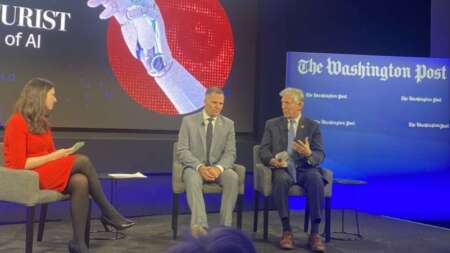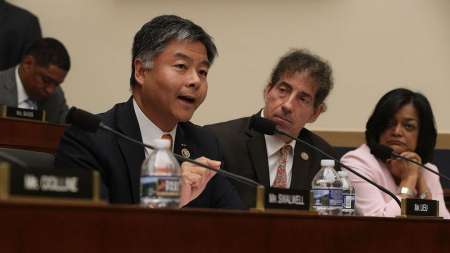Conrad Stosz, the Office of Management and Budget’s (OMB) director of artificial intelligence and a key player in helping OMB formulate final guidance to Federal agencies on implementing President Biden’s landmark AI executive order (EO), told MeriTalk in an exclusive interview that many public comments on the draft guidance have focused on issues of transparency, consistency, and risk management. […]
The National Science Foundation (NSF) launched its National AI Research Resource (NAIRR) pilot on Jan. 24, and already lawmakers and Feds are optimistic about the program’s ability to serve as a shared national infrastructure to support the AI research community and power responsible AI use. […]
The race to develop regulations for artificial intelligence technologies is on, and members of the House of Representatives are hoping to set up their own AI working group this month to help craft comprehensive regulations. […]
The Department of Defense (DoD) Chief Digital and Artificial Intelligence Office (CDAO) has launched the first of two artificial intelligence (AI) Bias Bounty exercises, the agency announced last week. […]
As artificial intelligence continues to become more widely leveraged, lawmakers introduced a new bill Thursday that aims to better understand the environmental impacts of the technology’s development and use. […]
House lawmakers and industry experts joined together in Los Angeles, Calif., on Feb. 2 to discuss artificial intelligence (AI) and intellectual property, showcasing wide support for the recently introduced No Artificial Intelligence Fake Replicas and Unauthorized Duplications (AI FRAUD) Act. […]
The Federal government is already using artificial intelligence technologies, but one tech expert this week explained that it’s crucial to leverage “radical collaboration” to put a formal AI governance model in place – such as an Authority to Operate (ATO). […]
The Defense Information Systems Agency (DISA) plans to pilot an artificial intelligence (AI) prototype to serve as a “digital concierge” to enhance its workforce’s capabilities, an agency official said. […]
A top official from the Department of Housing and Urban Development (HUD) said on Tuesday that his agency is looking to embrace artificial intelligence, starting by building a people-centric foundation. […]
The Department of Defense (DoD) needs new guidance aimed at better securing artificial intelligence (AI) systems and data in the department, according to a top DoD official. […]
Top Federal and industry IT experts said today that operationalizing AI at scale across the government requires leveraging existing governance frameworks, including President Biden’s recent AI executive order, to overcome hurdles with the emerging technology – like bias and transparency. […]
Federal agencies are already integrating artificial intelligence (AI) to support a range of government missions, but one Government Accountability Office (GAO) official said today that the Federal government is facing difficult decisions as it looks to implement new governance structures. […]
The General Services Administration (GSA) has released a draft framework on how its Federal Risk and Authorization Management Program (FedRAMP) will prioritize certain Cloud Service Offerings (CSOs) that provide specific generative AI technologies. […]
Federal agencies have been meeting “key” deadlines from President Biden’s artificial intelligence (AI) executive order (EO) and are even ahead of schedule on a handful of tasks, according to a three-month progress report the White House released today. […]
Artificial intelligence (AI) has the potential to flip the cyber threat landscape paradigm by helping defenders better mitigate future threats, a senior official at the Central Intelligence Agency (CIA) said on Thursday. […]
Officials at the Library of Congress, the U.S. Government Publishing Office (GPO), and the Smithsonian Institution are looking to leverage AI technologies to ease pain points for their employees and more efficiently deliver government services. […]
The National Science Foundation (NSF) officially launched the National Artificial Intelligence Research Resource (NAIRR) pilot today to serve as a shared national infrastructure to support the AI research community and power responsible AI use. […]
Jonathan Finch, acting director for digital experience in the Office of Management and Budget’s (OMB) Federal CIO office, said today that OMB is evaluating the utility of artificial intelligence technologies as it looks to execute on multiple directives to improve how the government provides digital services to citizens. […]
The director of the White House’s Office of Science and Technology Policy (OSTP) said today that Federal privacy legislation must work in harmonization with Congress’ forthcoming legislation to create guardrails on artificial intelligence (AI) development. […]
The “No Artificial Intelligence Fake Replicas and Unauthorized Duplications (AI FRAUD) Act” – introduced this week by Reps. Madeleine Dean, D-Pa., and Maria Salazar, R-Fla. – aims to protect Americans’ identities from misuse via AI. […]
Rep. Ted Lieu, D-Calif. – alongside Reps. Zach Nunn, R-Iowa, Don Beyer, D-Va., and Marcus Molinaro, R-N.Y. – this week introduced the Federal AI Risk Management Act, a bipartisan and bicameral bill to require U.S. Federal agencies and vendors to follow the AI risk management guidelines put forth by the National Institute of Standards and Technology (NIST). […]
The Information Technology Industry Council (ITI) tech trade group has published a new guide for global policymakers focused on critical areas of AI technology as part of the organization’s AI Futures Initiative. […]
Experts from government and academia said this week that successful adoption of artificial intelligence (AI) technologies depends on a host of factors including strong leadership on the technology front, along with a good understanding of the contents of data sets that are used to train AI applications. […]
The Aspen Institute’s US and Global Cybersecurity Groups released a new report on Tuesday that offers up recommendations on how to safely use AI in cybersecurity and steers organizations toward a “good place” where AI predominantly helps defenders. […]
When generative AI first made waves with the launch of ChatGPT in late 2022, one major concern that arose within the Federal government and beyond was the idea that the tool would steal people’s jobs. Something akin to the opposite of that trend emerged today at a hearing of the Senate Homeland Security and Governmental Affairs Committee. […]
As the United States continues its work on developing AI regulations, one industry expert said today that “radical collaboration” between tech companies and policymakers will be crucial to that process. […]
The National Telecommunications and Information Administration (NTIA) will share its recommendations on artificial intelligence (AI) accountability policy “soon,” NTIA Administrator Alan Davidson said in a 2023 year-in-review blog post. […]
Reps. Don Beyer, D-Va., and Anna Eshoo, D-Calif., have introduced new legislation that aims to make artificial intelligence models more transparent by requiring the creators of these models to make certain information publicly available to consumers. […]
The Office of Personnel Management (OPM) has authorized a government-wide direct hire authority for artificial intelligence (AI) positions, in an effort to help with the AI hiring surge following President Biden’s recent AI executive order (EO). […]
2023 was the year of artificial intelligence (AI), and MeriTalk can say without a shadow of a doubt that 2024 will be just as action-packed with Federal AI goodies. […]

























